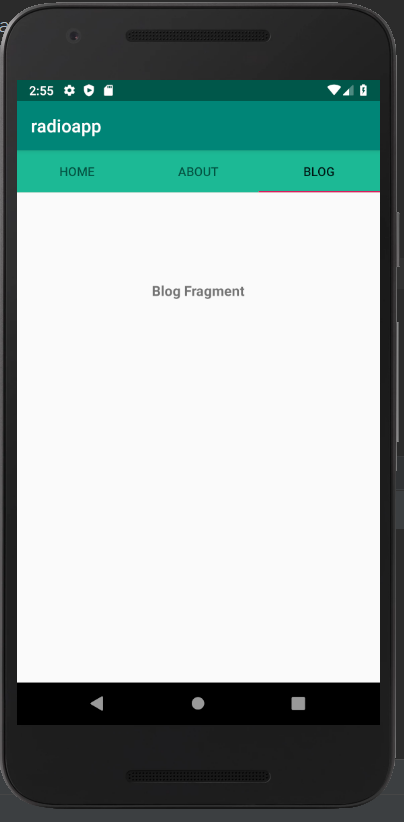After the deprecation of ActionBar.TabListener (API level 21), the TabLayout is released by Android which is used to implement horizontal tabs. To implement tabs, the TabLayout is introduced in the design support library. The TabLayout class provides the newTab() method to create Tabs. The setText(int) and setIcon(int) methods of the TabListener interface are used to set the title and icon of Tabs. The addTab(Tab) method is used to attach the Tabs of the layout over the TabLayout.
Syntax:
TabLayout tabLayout = (TabLayout)findViewById(R.id.tabLayout); tabLayout.addTab(tabLayout.newTab().setText("Tab 1")); tabLayout.addTab(tabLayout.newTab().setText("Tab 2")); tabLayout.addTab(tabLayout.newTab().setText("Tab 3")); |
Syntax: To add the tab items to TabLayout using TabItem of android design widget.
<android.support.design.widget.TabItem android:text="@string/tab_text"/> |
Example of TabLayout using ViewPager:
In the below example, we are demonstrating the use of the TabLayout using ViewPager and Fragment.
File: activity _main.xml:
<?xml version="1.0" encoding="utf-8"?> <RelativeLayout xmlns:android="http://schemas.android.com/apk/res/android" xmlns:tools="http://schemas.android.com/tools" android:layout_width="match_parent" android:layout_height="match_parent" tools:context="com.example.radioapp.MainActivity"> <android.support.design.widget.TabLayout android:id="@+id/tabLayout" android:layout_width="match_parent" android:layout_height="wrap_content" android:background="#1db995"> </android.support.design.widget.TabLayout> <android.support.v4.view.ViewPager android:id="@+id/viewPager" android:layout_width="wrap_content" android:layout_height="wrap_content" android:layout_below="@id/tabLayout" android:layout_centerInParent="true" android:layout_marginTop="100dp" tools:layout_editor_absoluteX="8dp" /> </RelativeLayout> |
File: build.gradle:
In the build.gradle file, we will add the dependency library of the TabLayout.
apply plugin: 'com.android.application' android { compileSdkVersion 28 defaultConfig { applicationId "com.example.radioapp" minSdkVersion 23 targetSdkVersion 28 versionCode 1 versionName "1.0" testInstrumentationRunner "android.support.test.runner.AndroidJUnitRunner" } buildTypes { release { minifyEnabled false proguardFiles getDefaultProguardFile('proguard-android-optimize.txt'), 'proguard-rules.pro' } } } dependencies { implementation fileTree(dir: 'libs', include: ['*.jar']) implementation 'com.android.support:appcompat-v7:28.0.0' implementation 'com.android.support.constraint:constraint-layout:1.1.3' implementation 'com.android.support:design:28.0.0' implementation 'com.android.support:support-v4:28.0.0' testImplementation 'junit:junit:4.12' androidTestImplementation 'com.android.support.test:runner:1.0.2' androidTestImplementation 'com.android.support.test.espresso:espresso-core:3.0.2' } |
File: MainActivity.java:
To make the slides of the different fragments of tabs we are implementing an additional listener addOnPageChangeListener(listener) of ViewPager and to select the current tab on tab selection we are implementing another additional listener addOnTabSelectedListener(listener) of TabLayout, in the MainActivity.java file.
package com.example.radioapp; import android.support.v7.app.AppCompatActivity; import android.os.Bundle; import android.support.design.widget.TabLayout; import android.support.v4.view.ViewPager; import app.com.sample.R; public class MainActivity extends AppCompatActivity { TabLayout tabLayout; ViewPager viewPager; @Override protected void onCreate(Bundle savedInstanceState) { super.onCreate(savedInstanceState); setContentView(R.layout.activity_main); tabLayout = findViewById(R.id.tabLayout); viewPager = findViewById(R.id.viewPager); tabLayout.addTab(tabLayout.newTab().setText("Home")); tabLayout.addTab(tabLayout.newTab().setText("About")); tabLayout.addTab(tabLayout.newTab().setText("Blog")); tabLayout.setTabGravity(TabLayout.GRAVITY_FILL); final MyAdapter adapter = new MyAdapter(this,getSupportFragmentManager(), tabLayout.getTabCount()); viewPager.setAdapter(adapter); viewPager.addOnPageChangeListener(new TabLayout.TabLayoutOnPageChangeListener(tabLayout)); tabLayout.addOnTabSelectedListener(new TabLayout.OnTabSelectedListener() { @Override public void onTabSelected(TabLayout.Tab tab) { viewPager.setCurrentItem(tab.getPosition()); } @Override public void onTabUnselected(TabLayout.Tab tab) { } @Override public void onTabReselected(TabLayout.Tab tab) { } }); } } |
File: MyAdapter.java:
package com.example.radioapp; import android.content.Context; import android.support.v4.app.Fragment; import android.support.v4.app.FragmentPagerAdapter; import android.support.v4.app.FragmentManager; class MyAdapter extends FragmentPagerAdapter { Context context; int totalTabs; public MyAdapter(Context c, FragmentManager fm, int totalTabs) { super(fm); context = c; this.totalTabs = totalTabs; } @Override public Fragment getItem(int position) { switch (position) { case 0: Home homeFragment = new Home(); return homeFragment; case 1: About aboutFragment = new About(); return aboutFragment; case 2: Blog blogFragment = new Blog(); return blogFragment; default: return null; } } @Override public int getCount() { return totalTabs; } } |
For all different tabs, we will create different fragment files.
File: Home.java:
package com.example.radioapp; import android.os.Bundle; import android.support.v4.app.Fragment; import android.view.LayoutInflater; import android.view.View; import android.view.ViewGroup; import app.com.sample.R; public class Home extends Fragment { public Home() { // Required empty public constructor } @Override public View onCreateView(LayoutInflater inflater, ViewGroup container, Bundle savedInstanceState) { return inflater.inflate(R.layout.fragment_home, container, false); } } |
File: fragment_home.xml:
<?xml version="1.0" encoding="utf-8"?> <FrameLayout xmlns:android="http://schemas.android.com/apk/res/android" xmlns:tools="http://schemas.android.com/tools" android:layout_width="match_parent" android:layout_height="match_parent" tools:context=".Home"> <!-- TODO: Update blank fragment layout --> <TextView android:layout_width="match_parent" android:layout_height="match_parent" android:textAlignment="center" android:text="Home Fragment" android:textSize="16sp" android:textStyle="bold"/> </FrameLayout> |
File: About.java:
package com.example.radioapp; import android.os.Bundle; import android.support.v4.app.Fragment; import android.view.LayoutInflater; import android.view.View; import android.view.ViewGroup; import app.com.sample.R; public class About extends Fragment { public About() { // Required empty public constructor } @Override public View onCreateView(LayoutInflater inflater, ViewGroup container, Bundle savedInstanceState) { return inflater.inflate(R.layout.fragment_about, container, false); } } |
File: fragment_about.xml:
<?xml version="1.0" encoding="utf-8"?> <FrameLayout xmlns:android="http://schemas.android.com/apk/res/android" xmlns:tools="http://schemas.android.com/tools" android:layout_width="match_parent" android:layout_height="match_parent" tools:context=".About"> <TextView android:layout_width="match_parent" android:layout_height="match_parent" android:textAlignment="center" android:text="About Fragment" android:textSize="16sp" android:textStyle="bold"/> </FrameLayout> |
File: Blog.java:
package com.example.radioapp; import android.os.Bundle; import android.support.v4.app.Fragment; import android.view.LayoutInflater; import android.view.View; import android.view.ViewGroup; import app.com.sample.R; public class Blog extends Fragment { public Blog() { // Required empty public constructor } @Override public View onCreateView(LayoutInflater inflater, ViewGroup container, Bundle savedInstanceState) { return inflater.inflate(R.layout.fragment_blog, container, false); } } |
File: fragment_blog.xml:
<?xml version="1.0" encoding="utf-8"?> <FrameLayout xmlns:android="http://schemas.android.com/apk/res/android" xmlns:tools="http://schemas.android.com/tools" android:layout_width="match_parent" android:layout_height="match_parent" tools:context=".Blog"> <!-- TODO: Update blank fragment layout --> <TextView android:layout_width="match_parent" android:layout_height="match_parent" android:textAlignment="center" android:text="Blog Fragment" android:textSize="16sp" android:textStyle="bold"/> </FrameLayout> |
File: AndroidManifest.xml:
<?xml version="1.0" encoding="utf-8"?> <manifest xmlns:android="http://schemas.android.com/apk/res/android" package="app.com.sample"> <application android:allowBackup="true" android:icon="@mipmap/ic_launcher" android:label="@string/app_name" android:roundIcon="@mipmap/ic_launcher_round" android:supportsRtl="true" android:theme="@style/AppTheme"> <activity android:name="com.example.radioapp.MainActivity"> <intent-filter> <action android:name="android.intent.action.MAIN" /> <category android:name="android.intent.category.LAUNCHER" /> </intent-filter> </activity> </application> </manifest> |
Output 1:

Output 2:

Output 3:

